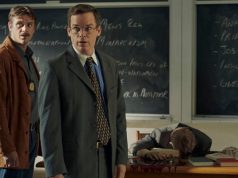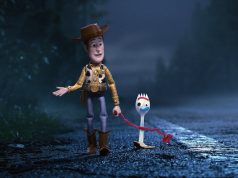Pixar’s latest computer-animated masterpiece, “WALL-E,” is so full of technical innovation, risk-taking, and awe-inspiring imagination that you can get wrapped up in those elements and forget how flat-out entertaining it is. Or, conversely, you could enjoy the immensely satisfying story, the sympathetic characters, and the inventive humor and not even notice how daring the film is, how it raises the bar yet again on the standards for animation, and how it is possibly the first robot chick flick ever made.
“WALL-E,” an instant classic if ever I’ve seen one, offers something for everyone, and it does so on several levels. It’s fundamentally a boy-meets-girl romance, but it’s just as fundamentally a futuristic science-fiction adventure. It features homages to the biblical stories of Adam and Eve and Noah’s Ark, as well as to “2001: A Space Odyssey,” “Alien,” “Star Wars,” and the silent comedies of Buster Keaton and Charlie Chaplin. It’s hilarious, suspenseful, and charming. It’s innocent and exhilarating. It can make you laugh, it can make you cry. It’s the best film of the first half of 2008, and sure to be better than most of what’s released in the second half, too.
It’s set in the late 2700s, several centuries after humans finally filled the Earth with so much garbage that life was no longer sustainable and they had to leave. (Yes, there’s a “give a hoot, don’t pollute” message, but it’s not strident or political.) The cockroaches survived, of course, and the Twinkies are still fresh. But the only other sign of life is a lonely robot who’s still doing what he was programmed to do 700 years earlier: collect trash, compact it into cubes, and gather the cubes into tidy stacks.
He’s called WALL-E, short for Waste Allocation Load Lifter, Earth-Class. He’s a squat, solar-powered, turtle-ish little fellow with soulful binocular eyes and a fondness, like Ariel the mermaid, for human stuff. As he patrols the vast expanses of trash, making skyscraper-size stacks of garbage cubes, he hangs on to whatever artifacts he finds interesting and takes them back to his storage shed. One of the film’s many pure, simple sight gags has him finding a plastic spork and then being uncertain where to file it — does it go with the forks or with the spoons? He settles for laying it down between them.
Except for a cockroach pal that he keeps as a pet, WALL-E is pretty isolated until the day a spacecraft arrives and deposits EVE. She’s a sleek robot, gleaming white and designed like an Apple component, and she’s indifferent to the earnest WALL-E (after determining he’s not a threat to her, that is). Her directive is classified. WALL-E, who has learned about love and dancing and hand-holding from an old VHS tape of “Hello, Dolly!” that he frequently re-watches, is instantly smitten.
The two wind up aboard a spacecraft, as the film’s trailer hints, and more cinematic treasures await us there. Mankind, it turns out, didn’t manage to colonize any other planets after leaving Earth; instead, the humans have been living on a giant intergalactic cruise ship, growing fatter and lazier with each passing generation, relying more and more on robots to do everything for them. The ship’s captain (voice of Jeff Garlin) is barely even aware of what Earth life was like 700 years ago. You mean people used to walk around on their feet instead of lounging on floating chairs?
The film is teeming with small joys, subtle jokes, and sublime details — all the hallmarks of a Pixar production. Yet I marvel at how different it is from previous Pixar films, too. The first 45 minutes are almost dialogue-free, as WALL-E and EVE communicate through robotic beeps and whistles rather than language. (Kudos to Ben Burtt’s brilliant sound design for making it sound authentic and still human-like.) There are actual clips from “Hello, Dolly!,” as well as non-animated footage of Fred Willard as the CEO of the conglomerate that helped over-pollute the Earth. Where Pixar’s past efforts have mostly been about friendship or family, this one is about romantic love — romantic love between robots, I might add.
But that’s what has made Pixar the venerated organization that it is. Each film manifests a loving attention to detail and a devotion to storytelling (it’s never just a set-up for gags), and there’s always a happy ending. But the giddy nerds at Pixar headquarters aren’t afraid to take chances, either. “Finding Nemo” begins with a fish’s wife and most of their unborn children being killed by a barracuda. “The Incredibles” has a woman concerned about her husband’s marital fidelity. “Ratatouille” is about a filthy rat who wants to be a gourmet chef, for crying out loud. On paper, all of those sound like bad ideas for a children’s cartoon, and any focus group or committee would ensure that they be watered down. Thank goodness Pixar doesn’t listen to focus groups or committees.
“WALL-E,” which was written and directed by “Finding Nemo’s” Andrew Stanton, boasts a vision of the future that’s as vivid and plausible as any sci-fi film to come before it. You can see the intricacies in the space-age designs and mechanics. The various types of robots (and there are many more on the space cruiser, including a loony bin full of malfunctioning droids) look like they could actually be built and expected to perform they way they do on film. They don’t move like traditional animated characters, either, with bodies that stretch and bend whimsically. They move only the way real robots of their design would move in the real world.
Yes — it’s cartoon robots behaving like live-action humans. WALL-E and EVE, despite being made of steel and polymers and not really speaking, manage to express an astonishing array of emotions. Their story — WALL-E an earnest, love-struck puppy dog, EVE a strong, career-minded woman — plays out as sweetly and tenderly as if they were people. Having already made us care about toys, bugs, monsters, fish, cars, and rats, I guess it shouldn’t come as a surprise that Pixar has made robots seem lovable. But here I am, surprised and delighted all over again at just how well these people can tell a story.
A (1 hr., 39 min.; )





